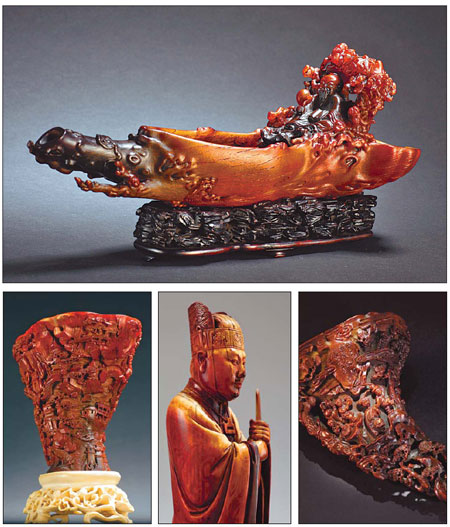Artistry on the horns of antiquity
 0 Comment(s)
0 Comment(s) Print
Print E-mail
China Daily, April 6, 2011
E-mail
China Daily, April 6, 2011
|
|
|
Clockwise from top: Rhinoceros horn carving "Zhangqian (a famous historical figure) in a raft" from Ming Dynasty (1368-1644), 28 cm long; Ming libation cup, 28 cm long; Ming ivory carving of official, 22.5 cm high; Cup carved with figures from Qing Dynasty (1644-1911), 17 cm long, 13.5 cm high. [Photo: China Daily] |
Open for viewing at the Poly Arts Museum, this latest exhibition showcases more than 60 exceptional rhinoceros horn and ivory carvings from the Ming (1368-1644) and Qing (1644-1911) dynasties.
The carvings are owned by A&J Speelman, a family antiques business in operation for more than 100 years and spanning three generations in the United Kingdom.
First introduced to Chinese ceramics in the 1960s by his father, Jules Speelman helplessly fell in love with all genres of Chinese art.
"You can also find rhinoceros horn carvings in Japan or India, but I think the Chinese carvings, in some aspect, represent the highest standard," said the third-generation scion.
Although he has been to Beijing several times, this is the first time he has brought along his treasured collection and set up an exhibition here, he said.
Rhinoceros horn was once considered an auspicious item and was a medicinal ingredient described in ancient literature. It was also carved into objects and greatly favored by emperors and the wealthy.
With their tapered shape, rhinoceros horns found a natural use as wine vessels, and this exhibition shows libation cups displaying a wide range of forms, designs and techniques, including a number of signed works from master carvers.
Highlights include a 28-centimeter-long Ming libation cup, decorated with 26 boys playing in a garden. Some climb trees, some play hide-and-seek, while others play cuju, an old form of Chinese soccer. The skillful carving, which captures different emotions and movements, demonstrates the technical mastery the craftsmen achieved in this period.
Rich in symbolism, this libation cup would have been used as an auspicious object or given as a present with a wish for many descendants and a blessing for long life.
According to Du Naisong, senior researcher at the Palace Museum, the demand for rhinoceros horns for household use began in prehistoric times.
The scarcity of the mammal made the raw material precious even in the Tang Dynasty (AD 618-907). Only the emperor and the crown prince could use hairpins made of rhino horn to fix their imperial crowns in place, and officials wore waistbands made of rhinoceros according to their ranks.
The rhinoceros horns on display are not only beautifully designed as decorative art, but also have the "scholar's taste" as the themes of these carvings are not confined to landscapes, birds and flowers. The craftsmen also got their inspiration from ancient literature and inscribed beautiful lines of poems on the items, Du added.
Besides rhinoceros horn carvings, also on view are fine examples of ivory carvings, including Buddha statues, boxes and figures of ladies, as well as a ruyi scepter, a traditional Chinese object to send a birthday greeting.
Nowadays, the protection of rhinoceroses has stopped the supply of material for horn carving, so legal possession of such artworks is rare. It is estimated there are now fewer than 4,000 Chinese rhinoceros horn carvings that can be found, making these works of art highly valued in the hearts of collectors.

Go to Forum >>0 Comment(s)